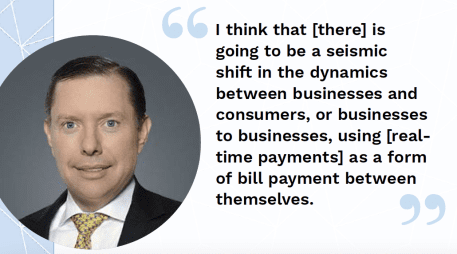Real-Time Payments’ Present and Future

The bullish forecast comes from the latest edition of the “Real-Time Payments Tracker®,” where Chris Ward, head of wholesale payments at Truist Financial, tells PYMNTS how this exponential and seismic shift in real-time payments will also create a completely new dynamic between businesses and consumers.
An interview with Chris Ward, head of wholesale payments at Truist Financial.
 This has been a banner year for the RTP® network and real-time payments in general, with the ongoing pandemic fueling businesses’ and consumers’ desires for quick and seamless transactions. PYMNTS talked to Truist Financial’s Chris Ward, head of wholesale payments, about some of the most exciting developments in real-time payments this past year and what to look forward to in the future.
This has been a banner year for the RTP® network and real-time payments in general, with the ongoing pandemic fueling businesses’ and consumers’ desires for quick and seamless transactions. PYMNTS talked to Truist Financial’s Chris Ward, head of wholesale payments, about some of the most exciting developments in real-time payments this past year and what to look forward to in the future.
“One new development in real-time payments is that it really enables [requests for payment] to be executed [by] using somebody’s mobile number or email address, so you don’t have to have bank account information, even in cross-border [transactions]. You can execute it all in less than 10 seconds, and that’s been a huge success.”
The future of real-time payments is looking no less sunny than its present. Ward pointed out that banks and businesses are integrating the RTP network in record numbers. ![]() While it still comprises a small minority of overall digital transactions in the U.S., the expanding payment volume is fostering a radical shift in the way businesses and consumers transact with one another. New use cases are emerging by the day, offering new types of businesses and consumers an on-ramp to the RTP network.
While it still comprises a small minority of overall digital transactions in the U.S., the expanding payment volume is fostering a radical shift in the way businesses and consumers transact with one another. New use cases are emerging by the day, offering new types of businesses and consumers an on-ramp to the RTP network.
“As more and more banks continue to come online, and with the maturing of the market, I think you’re going to see the volume continue to spike up, with more people presenting bills through the RTP network.”
The biggest benefit of real-time payments adoption is increased control over money flow, said Ward. As real-time payments continue to grow more popular, consumers can have greater access to funds, less economic anxiety and faster payroll to avoid economic uncertainties. Individuals can have more power and control over their financial lives and peace of mind when it comes to monetary matters. Greater real-time payments integration could be a gamechanger for everyday consumers.
“The more we enable individuals and businesses to access real-time payments, it’s going to help with financial inclusion and having much more control over the flow of funds coming into and out of their accounts. I think real-time payments is a really good avenue to put the power in the customer’s hands. My biggest hope is that we’ll have the majority of bill payments and P2P payments flowing over the RTP network over the next couple of years.”
